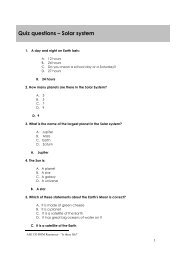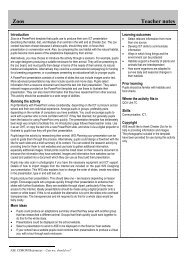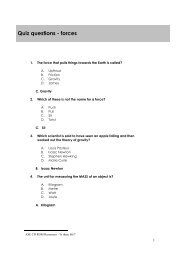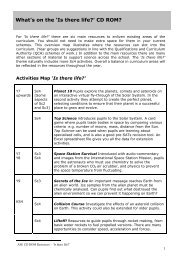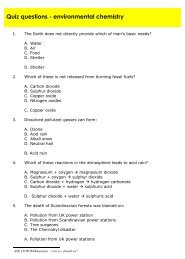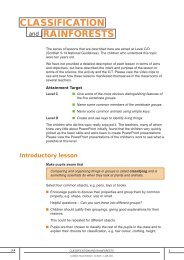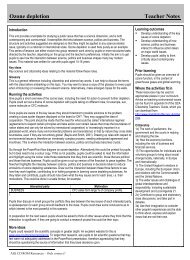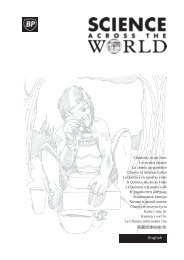Role-play in science teaching and learning - ASE Science Year CD ...
Role-play in science teaching and learning - ASE Science Year CD ...
Role-play in science teaching and learning - ASE Science Year CD ...
Create successful ePaper yourself
Turn your PDF publications into a flip-book with our unique Google optimized e-Paper software.
<strong>Role</strong>-<strong>play</strong> <strong>in</strong> <strong>science</strong> teach<strong>in</strong>g <strong>and</strong> learn<strong>in</strong>g<br />
McSharry <strong>and</strong> Jones<br />
BOX 1<br />
Play<br />
Games<br />
Simulation<br />
Work<strong>in</strong>g def<strong>in</strong>itions of role-<strong>play</strong>’s relatives<br />
A behaviour used dur<strong>in</strong>g the development of children to learn about their environment which<br />
produces enjoyment (Piaget, 1951). The ‘environment’ <strong>in</strong>cludes physical objects,<br />
<strong>in</strong>teractions <strong>and</strong> societal rules of conduct.<br />
Games are like <strong>play</strong> except that they usually have an end, a payoff’ (Adams, 1973). Games<br />
have conserved rules which can be used <strong>in</strong> competition with the hope of w<strong>in</strong>n<strong>in</strong>g (Piaget,<br />
1932).<br />
is the ‘imitation of conditions, pretend<strong>in</strong>g to have or be someth<strong>in</strong>g’ (Concise Oxford English<br />
Dictionary, 1978). In education, simulation is often referred to as ‘simulation games’, which<br />
are usually more controlled than be<strong>in</strong>g mere extensions of games, <strong>and</strong> are ‘detailed models<br />
<strong>in</strong>tended to reflect a situation found <strong>in</strong> the real world’ (Adams, 1973).<br />
There are other reasons why role-<strong>play</strong> may be a<br />
valuable educational tool:<br />
■ It gives <strong>science</strong> teachers another option that can<br />
be used to l<strong>in</strong>k their work with ‘the more feel<strong>in</strong>g,<br />
creative side of education <strong>and</strong> as a method of<br />
<strong>in</strong>creas<strong>in</strong>g the manipulation of factual material by<br />
children’ (Watson, 1985), a good example of which<br />
would be ask<strong>in</strong>g children to describe the water<br />
cycle to their peers <strong>in</strong> the role of television weather<br />
presenters.<br />
■ It gives children a feel<strong>in</strong>g of ‘ownership’ of their<br />
education (Danby <strong>and</strong> Upitis, 1988). ‘Ownership’<br />
refers to the way a child facilitates their own<br />
learn<strong>in</strong>g by creat<strong>in</strong>g their own role-<strong>play</strong>s through<br />
either scripted or improvised work, for example<br />
to expla<strong>in</strong> the way the planets orbit the Sun.<br />
■ It can be used effectively to teach about moral or<br />
ethical issues aris<strong>in</strong>g from the curriculum (Colby,<br />
1987), for example debates about genetically<br />
manipulated food production or the arguments for<br />
<strong>and</strong> aga<strong>in</strong>st the open<strong>in</strong>g of a new quarry <strong>in</strong> the<br />
school’s <strong>play</strong><strong>in</strong>g field.<br />
■ It can help children across the full spectrum of<br />
educational needs to ‘<strong>in</strong>terpret their place <strong>in</strong> the<br />
world’ (Cayton, 1989). Merely expla<strong>in</strong><strong>in</strong>g to<br />
children about their environment <strong>in</strong> the course of<br />
a theory lesson may not be the best method for<br />
help<strong>in</strong>g them to ga<strong>in</strong> an underst<strong>and</strong><strong>in</strong>g of why it is<br />
there or how the processes at work <strong>in</strong> the environment<br />
have formed it. <strong>Role</strong>-<strong>play</strong>s, such as those<br />
describ<strong>in</strong>g predator–prey relationships or why day<br />
<strong>and</strong> night occur, give children a chance to<br />
experience these events <strong>in</strong> a physical way, which<br />
may be more appropriate to their personal learn<strong>in</strong>g<br />
style.<br />
■ Many role-<strong>play</strong>s are based upon analogy, which<br />
helps children to conceptualise <strong>and</strong> greatly<br />
<strong>in</strong>creases learn<strong>in</strong>g (Lawson, 1993) about, for<br />
example, k<strong>in</strong>etic theory, electrical currents <strong>and</strong><br />
antibody–antigen <strong>in</strong>teractions.<br />
So what’s wrong with role-<strong>play</strong>?<br />
Some teachers tend to prefer children to watch <strong>and</strong><br />
listen dur<strong>in</strong>g their lessons, rather than tak<strong>in</strong>g part <strong>in</strong><br />
the physical <strong>and</strong> <strong>in</strong>tellectual activity engendered by<br />
role-<strong>play</strong> (Lawrence, 1997). This could be because<br />
teachers are used to watch<strong>in</strong>g <strong>and</strong> listen<strong>in</strong>g, hav<strong>in</strong>g<br />
themselves been taught like that, or perhaps they f<strong>in</strong>d<br />
it difficult to underst<strong>and</strong> the educational needs of<br />
children because they have actually passed through<br />
the Piagetian stages of development which they are<br />
try<strong>in</strong>g to encourage <strong>in</strong> their pupils. Lawrence (1997)<br />
says that ‘unless the teach<strong>in</strong>g methodology embraces<br />
... a wide variety of techniques, any pupil/student whose<br />
style does not match is likely to be disadvantaged’.<br />
Perhaps this mismatch of teach<strong>in</strong>g/learn<strong>in</strong>g styles<br />
could be why children’s motivation <strong>in</strong> <strong>science</strong> lessons<br />
has become difficult to ma<strong>in</strong>ta<strong>in</strong>. The lack of enthusiasm<br />
for the <strong>science</strong>s amongst children may have also<br />
served to proliferate the widespread public op<strong>in</strong>ion that<br />
<strong>science</strong> is at best irrelevant, <strong>and</strong> actually bor<strong>in</strong>g <strong>and</strong>/<br />
or difficult to study (Osborne, Millar <strong>and</strong> Coll<strong>in</strong>s,<br />
1999).<br />
Other agencies have already realised the effectiveness<br />
of role-<strong>play</strong> for use <strong>in</strong> staff tra<strong>in</strong><strong>in</strong>g, from health<br />
care, management <strong>and</strong> adm<strong>in</strong>istration to urban<br />
plann<strong>in</strong>g <strong>and</strong> neighbourhood development schemes<br />
(Saunders, Percival <strong>and</strong> Vartia<strong>in</strong>en, 1996). It would<br />
be ironic if commercial enterprise took the lead from<br />
education <strong>in</strong> the race to reform <strong>and</strong> rehabilitate<br />
education by us<strong>in</strong>g techniques which mean someth<strong>in</strong>g<br />
to the taught.<br />
However, role-<strong>play</strong> is used <strong>in</strong> teachers’ <strong>in</strong>-service<br />
tra<strong>in</strong><strong>in</strong>g (INSET), often to address topics perceived as<br />
74 School <strong>Science</strong> Review, September 2000, 82(298)




